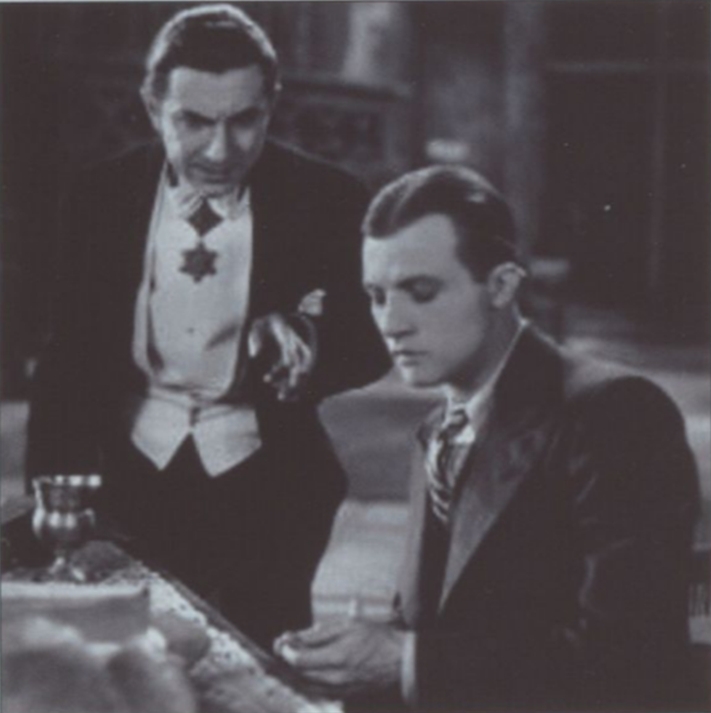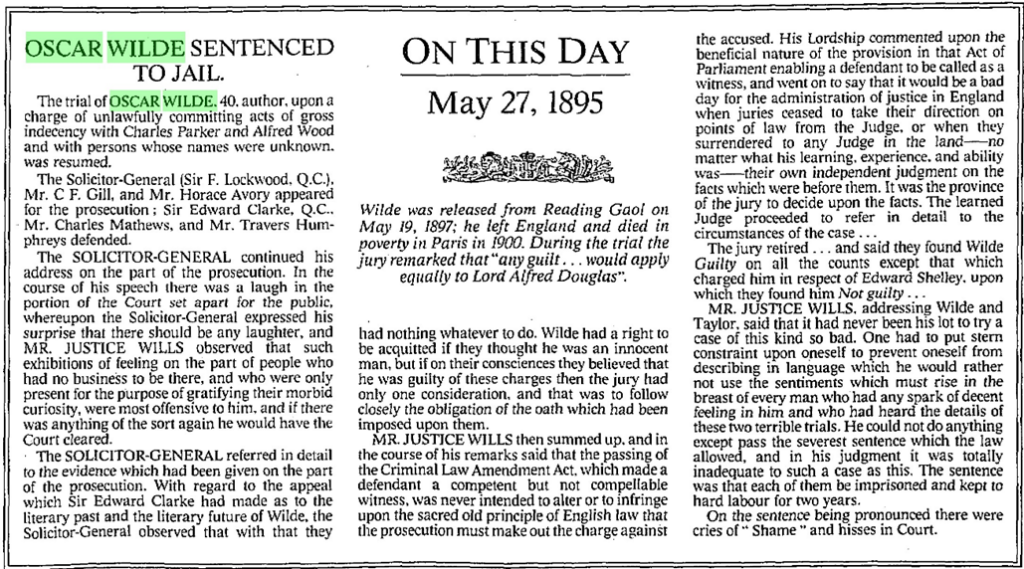Why homoromantic and homoerotic interpretations of classic literature are as critical as traditional readings.
|By Brittany Pope, Gale Ambassador at the University of Wyoming |
The Victorian period gave rise to many of today’s genres—Sir Arthur Conan Doyle’s Sherlock Holmes and Bram Stoker’s Dracula became codifiers of detective and horror fiction. Then there are the works of Oscar Wilde— from the fairy tale The Happy Prince to the Gothic classic The Portrait of Dorian Gray, which is still read and adapted to this day. Aside from being the literary giants who inspired countless authors and kick-started specific genres within the nineteenth century, there is another commonality for many of the disparate works: an element of queerness peeking from between the lines and in the phrasings, whether intentionally left there by the author or existing in the mind of the reader.
As any historian or LGBTQ+ activist can tell you, making solid assumptions of the heteronormativity or nonheteronormative nature of a person or body of work that isn’t explicit is a touchy matter—especially when looking into the past, where gender, sexuality, and social norms were quite different from the twenty-first century. However, there can be educated guesses based on context. There is a notable intersection between genre fiction, such as horror and science fiction, and LGBTQ+ experiences, and it’s a surprisingly old and storied history. Unfortunately, a segment of the population in both academia and general culture views attempts to find these traces as either unnecessary or insulting to the original writers.
Dracula, Equal-Opportunity Predator
Bram Stoker’s Dracula is dripping with as much sensuality as allowed by Victorian standards, with successive adaptations turning the sensual subtext into overt flaunting of sexuality. Still, often a heterosexual sensuality raised brows, like during Jonathan’s imprisonment when Harker had made the mistake of sneaking out in the middle of the night and was imperiled by three vampiric women (often referred to as Dracula’s brides, but the text implied to be either his daughters or other relatives, given their uncanny physical resemblance to him); the sheer possessiveness Dracula displays; followed by the women enigmatically taunting the count about not knowing love as such:
“How dare you touch him, any of you? How dare you cast eyes on him when I had forbidden it? Back, I tell you all! This man belongs to me! Beware how you meddle with him, or you’ll have to deal with me.” The fair girl, with a laugh of ribald coquetry, turned to answer him:—
“You yourself never loved; you never love!” On this the other women joined, and such a mirthless, hard, soulless laughter rang through the room that it almost made me faint to hear; it seemed like the pleasure of fiends. Then the Count turned, after looking at my face attentively, and said in a soft whisper:—“Yes, I too can love; you yourselves can tell it from the past. Is it not so? Well, now I promise you that when I am done with him you shall kiss him at your will. Now go! go! I must awaken him, for there is work to be done.”
Bram Stocker, Dracula

This part of Harker’s captivity is often left out in adaptations, highlighting an enigmatic exchange for a character who otherwise had shown nothing but a manipulative, predatory eye toward Jonathan and later Mina Harker, along with a general air of sadism. In context, Jonathan is in a state of a waking dream—a trance; the count and the women seem unaware that he is aware enough to follow the conversation, so it is unlikely that this was a ploy. This moment of tender vulnerability is shattered upon the promise of leaving the solicitor to the mercy of the women. A classic reading is, during this scene, Dracula was remembering his time as a mortal, but the focus of his gaze resulted in much ink spilled about the homoerotic subtext of the most famous vampire. Richard S. Primuth raises the question in Vampires Are Us whether Dracula is meant to be seen as a gay or bisexual figure and relates it to questions of Bram Stoker’s relationships with Oscar Wilde and Henry Irving—the latter considered to be the inspiration for the vampire’s personality and mannerisms.
Oscar Wilde and the Lack of Subtext
Oscar Wilde was perhaps the least subtle of these authors in LGBTQ+ subtext, mainly by the virtue that he is one of the creators that can be said with near certainty is gay or perhaps even bisexual. Thanks to an ill-advised slander lawsuit he mounted against the Marquis of Queensberry for attempting to put him over his relationship with the Marquis’s son, future Lord Alfred Douglas, aka Bosie Douglas, Wilde ran afoul of the sodomy and indecency laws of the day and found himself imprisoned, primarily because during his sodomy trial he refused to deny “The love that dares not speak its name.” His time in prison and the subsequent avoidance of his works in England had a chilling effect, causing works of same-sex attraction or nonheteronormative presentation of gender to be sent further underground and same-sex subcultures to become even more secretive to avoid public humiliation and legal shame. Perhaps because of his public flaunting of social norms—his same-sex relations were no secret even before the trials—he is the only author in this article whose works had not been given pushback against an LGBTQ+ reading by the virtue that Wilde, unlike Stoker, did little to hide his otherness in society.

They Were Roommates: The Case of Romantic Subtext in Sherlock Holmes
Sir Arthur Conan Doyle—much to his dismay—was most famous for the iconic detective Sherlock Holmes, who, save for a brief handful of tales, always had Dr. John H. Watson, his faithful Boswell, right at his side with a sidearm or medical bag ready. Later depictions, often based on previous adaptations or surface-level literacy, tend to reduce their dynamics to genius and the bumbling sounding board or Watson growing to resent Holmes, in-line with Doyle’s real-life frustration that nobody wanted to read anything he wrote that didn’t have Holmes in it. The actual stories present a far different dynamic—while Watson often grows frustrated or annoyed with Holmes’s flagrant disregard for social norms or unintentionally cruel remarks, there is much in the way of admiration and affection from both men. At the end of The Sign of the Four, at Watson’s announcement of his marriage to Mary Morstan, the detective reacts bitterly, bluntly telling him that he cannot congratulate the man, even if he thinks Mary is a lovely and intelligent woman, claiming it’s because he can’t abide by emotions. But it’s a later case that suggests a deeper reason for Holmes’s earlier bitterness at his roommate’s marriage after the culprit shoots Watson:
Then my friend’s wiry arms were round me, and he was leading me to a chair.
“You’re not hurt, Watson? For God’s sake, say that you are not hurt!”
It was worth a wound—it was worth many wounds—to know the depth of loyalty and love which lay behind that cold mask. The clear, hard eyes were dimmed for a moment, and the firm lips were shaking. For the one and only time I caught a glimpse of a great heart as well as of a great brain. All my years of humble but single-minded service culminated in that moment of revelation.
“It’s nothing, Holmes. It’s a mere scratch.”
He had ripped up my trousers with his pocket-knife.
“You are right,” he cried with an immense sigh of relief. “It is quite superficial.” His face set like flint as he glared at our prisoner, who was sitting up with a dazed face. “By the Lord, it is as well for you. If you had killed Watson, you would not have got out of this room alive. Now, sir, what have you to say for yourself?”
Doyle, The Adventures of the Three Garridebs
Yet still, some critics and reviewers consider seeing this moment as romantic as an insult to Doyle. While this article dates from the 1980s, such arguments are still heard in literary and historical circles today.

While unlike Stoker and Wilde, there is no known evidence that Doyle himself was nonheterosexual, the British literary circle of the time was small and close-knit, with many famous authors having met in passing or having shared the same agents. Wilde and Doyle had dinner at the Langham Hotel in August 1889, discussing their respective in-progress works: The Picture of Dorian Gray and The Sign of the Four. Stoker and Wilde had wooed the same woman, Florence Balcombe, with her choosing the former. Stoker had interviewed Doyle, and the two remained close friends for life. Doyle was a fan of Stoker’s employer, Irving. Yet the bohemian detective who disdains the company of women and flaunts other social norms may have been influenced by Doyle’s social circle. At least one later reviewer seems to think so.
There’s More Than One Way to Look at a Book
Why should one look for these things? Why does it matter? some may ask. The answer is, the modern ideas of heteronormativity: that heterosexuality is the norm, and, until recently, gender identity and representation is static and immutable, and same-gender attraction is deviant, and to some, a modern invention from “kids these days” wanting to annoy their parents and community. The latter, of course, is not true—and the ideas of relationships, gender identity, and, yes, even sexuality have changed over the entire existence of humanity. This line of thinking that trying to “find” an LGBTQ+ subtext lessens a work, insults the original author, or ruins a character plays on an assumption that being nonheterosexual is bad—and this is a point of view that needs to be challenged. Of course, there is also the question of how the same people who had no issue with reading The Picture of Dorian Gray as a novel with homoerotic undercurrents would deny the equal-opportunity predation of Dracula or the closeness of Holmes and Watson that might be seen as romantic if one had been written as a different gender. Perhaps it’s the simple fact that there is no denying Wilde’s identity as a gay man, while Stoker was notoriously private. Doyle seems straight to our modern concept of identity, so it seems “safer” and “less insulting” to not insinuate anything or that men who are not gay would not write characters who might be gay.
Looking for subtext serves multiple purposes—better understanding the novel’s intention and author, highlighting love and expressions that existed even in an era where it was made illegal and driven underground, or how our views on relationship norms changed over time. Reading between the lines also challenges the reader to consider their perceptions and biases, understanding that things might not be as they appear at first glance. It can even deepen the enjoyment or understanding of the work. And in the end, is there any harm in acknowledging that sometimes the text can be pretty darn gay? Why is this so bad?
If you enjoyed reading about literary interpretations of Victorian and Gothic literature, check out these posts:
- What is a monster? Tracking the evolution and reception of monstrosity in literature from the nineteenth century to modern day
- From Grimm to Gothic and Everything In Between: The Evolution of the Horror Genre
- The Ever-Changing State of Literary Criticism

Meet the Author
Brittany Pope is an undergraduate history major at the University of Wyoming, an avid reader, and a hobbyist writer. She enjoys digging deep into a good book and trying to work out what makes the characters tick, and how fiction can reflect the culture of the time it’s written in.

